日本食品添加剂使用标准
- 格式:pdf
- 大小:326.18 KB
- 文档页数:23

2011年第卷第期1410饮料工业日本发布了最新食品添加剂使用标准(2011年9月1日起生效)和指定食品添加剂名单(2011年9月5日起生效)。
日本的食品添加剂可分为“指定的食品添加剂”、“现存的食品添加剂”、“天然调味剂原料”和“通常作为食品也可作为食品添加剂的物质”。
(1)指定的食品添加剂1947年,日本食品卫生法对添加剂实施主动列表制度,即只允许在食品中使用日本厚生省指定的认为安全的食品添加剂。
在1995年之前,主动列表系统仅适用于化学合成的添加剂。
在1995年,日本对食品卫生法进行修订,使该系统涵盖除个别豁免外的所有合成及非合成添加剂。
指定的食品添加剂可分为有使用标准的食品添加剂及无使用标准的食品添加剂两类。
不受主动列表系统约束的食品添加剂包括以下几类:(2)现存的食品添加剂1995年法规修订之前,已经在市场上销售或使用的不受主动列表系统约束的食品添加剂,均为非化学合成添加剂。
1996年4月16日,日本后生省公布了现存食品添加剂清单。
(3)天然调味剂原料,不受主动列表系统约束;(4)通常作为食品也可作为食品添加剂的物质。
(食品产业网2011-09-16)日本发布最新食品添加剂使用标准Analysis and research on product structure adjustment of and green technology application in plasticsmachinery in “12th Five-Year Plan ”(Ⅴ)ZHANG You-gen(Ningbo Haida Plastics Machinery Co.,Ltd.,Ningbo 315200,Zhejiang ,China)Abstract :The application and development of green technology is the core of product structure adjustment of plastics machinery in “the 12th Five-year Plan ”.Green technology works mainly in the improvement of utilization efficiency of energy and otherresources ,the reduction of molding cost ,the abatement of environmental pollution ,the enhancement of cleanliness ,etc.Meddle-and low-end plastics machinery is not optimistic at present in China.The middle-and low-end markets will be the first to be affected if the plastics machinery market declines ,resulting in the biggest shock on domestic manufacturers ;high-end plastics machinery has a broad development space for satisfying the needs of scientific and technological progresses of the related industries.High-end plastics machinery is equipment fully reflecting the essence of green technology.Several issues were focused upon which need to be solved in the product structure adjustment of and green technology application in 4major categories of plastics machinery ,including injection -molding equipment ,stretching -blowing -molding equipment ,extruding equipment and insulating equipment.It will be the only way of changing the status of middle -and low -end plastics machinery and creating Chinese-made green technology to discard old concepts of development ,focus on innovation technology and development ideas ,accelerate the independent development of plastics machinery with scientific innovations ,launch high-end plastics machinery ,and master green core technology.Key words :plastics machinery ;product structure adjustment ;green technology ;independent innovation ;analysis and research CLC No.:TQ320.5Document code :Bdoi :10.3969/j.issn.1007-7871.2011.10.011机械、装备与设计50。
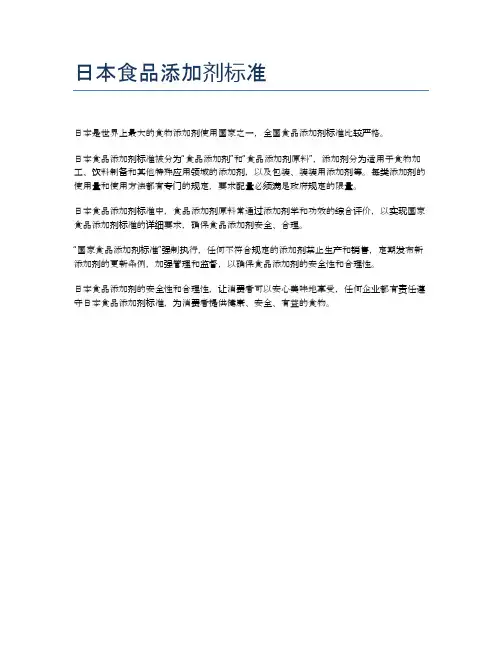
日本食品添加剂标准
日本是世界上最大的食物添加剂使用国家之一,全国食品添加剂标准比较严格。
日本食品添加剂标准被分为“食品添加剂”和“食品添加剂原料”,添加剂分为适用于食物加工、饮料制备和其他特殊应用领域的添加剂,以及包装、装装用添加剂等。
每类添加剂的使用量和使用方法都有专门的规定,要求配量必须满足政府规定的限量。
日本食品添加剂标准中,食品添加剂原料常通过添加剂学和功效的综合评价,以实现国家食品添加剂标准的详细要求,确保食品添加剂安全、合理。
“国家食品添加剂标准”强制执行,任何不符合规定的添加剂禁止生产和销售,定期发布新添加剂的更新条例,加强管理和监督,以确保食品添加剂的安全性和合理性。
日本食品添加剂的安全性和合理性,让消费者可以安心美味地享受,任何企业都有责任遵守日本食品添加剂标准,为消费者提供健康、安全、有益的食物。
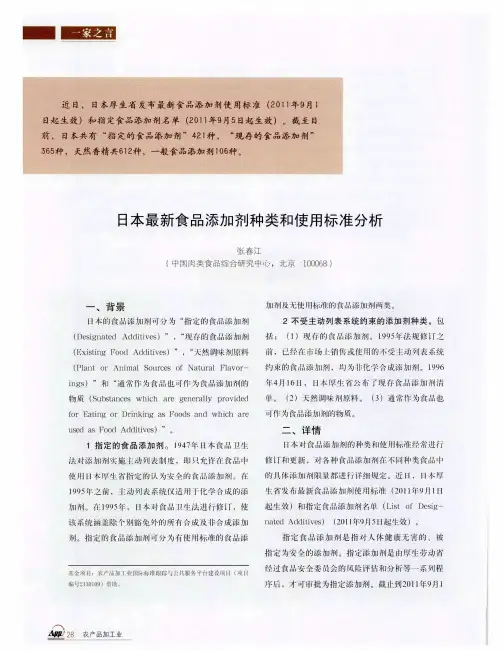

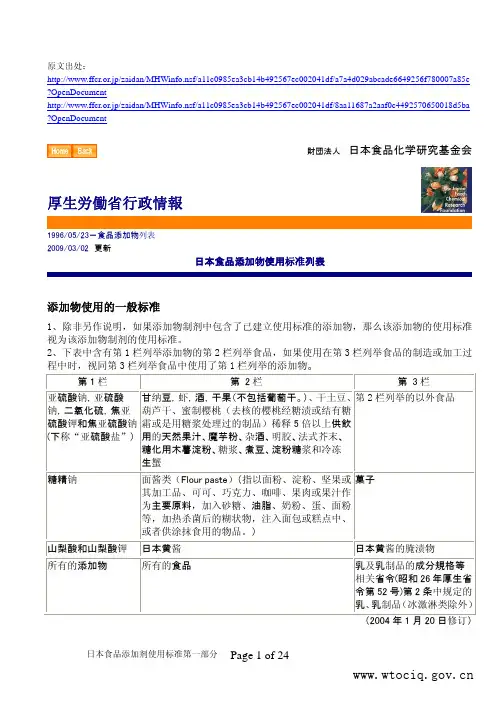
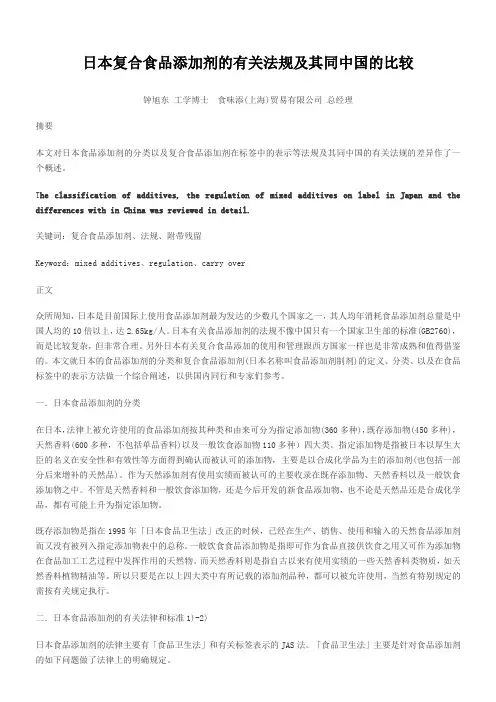
日本复合食品添加剂的有关法规及其同中国的比较钟旭东工学博士食味添(上海)贸易有限公司总经理摘要本文对日本食品添加剂的分类以及复合食品添加剂在标签中的表示等法规及其同中国的有关法规的差异作了一个概述。
T he classification of additives, the regulation of mixed additives on label in Japan and the differences with in China was reviewed in detail.关键词:复合食品添加剂、法规、附带残留Keyword:mixed additives、regulation、carry over正文众所周知,日本是目前国际上使用食品添加剂最为发达的少数几个国家之一,其人均年消耗食品添加剂总量是中国人均的10倍以上,达2.65kg/人。
日本有关食品添加剂的法规不像中国只有一个国家卫生部的标准(GB2760),而是比较复杂,但非常合理。
另外日本有关复合食品添加的使用和管理跟西方国家一样也是非常成熟和值得借鉴的。
本文就日本的食品添加剂的分类和复合食品添加剂(日本名称叫食品添加剂制剂)的定义、分类、以及在食品标签中的表示方法做一个综合阐述,以供国内同行和专家们参考。
一.日本食品添加剂的分类在日本,法律上被允许使用的食品添加剂按其种类和由来可分为指定添加物(360多种),既存添加物(450多种),天然香料(600多种,不包括单品香料)以及一般饮食添加物110多种)四大类。
指定添加物是指被日本以厚生大臣的名义在安全性和有效性等方面得到确认而被认可的添加物,主要是以合成化学品为主的添加剂(也包括一部分后来增补的天然品)。
作为天然添加剂有使用实绩而被认可的主要收录在既存添加物、天然香料以及一般饮食添加物之中。
不管是天然香料和一般饮食添加物,还是今后开发的新食品添加物,也不论是天然品还是合成化学品,都有可能上升为指定添加物。
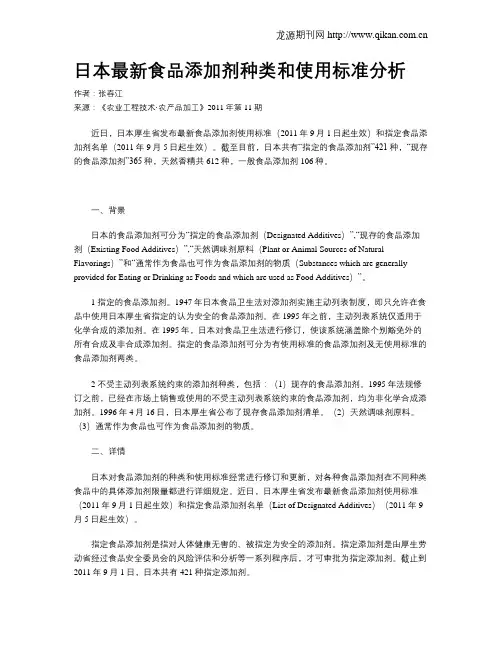
日本最新食品添加剂种类和使用标准分析作者:张春江来源:《农业工程技术·农产品加工》2011年第11期近日,日本厚生省发布最新食品添加剂使用标准(2011年9月1日起生效)和指定食品添加剂名单(2011年9月5日起生效)。
截至目前,日本共有“指定的食品添加剂”421种,“现存的食品添加剂”365种,天然香精共612种,一般食品添加剂106种。
一、背景日本的食品添加剂可分为“指定的食品添加剂(Designated Additives)”,“现存的食品添加剂(Existing Food Additives)”,“天然调味剂原料(Plant or Animal Sources of Natural Flavorings)”和“通常作为食品也可作为食品添加剂的物质(Substances which are generally provided for Eating or Drinking as Foods and which are used as Food Additives)”。
1 指定的食品添加剂。
1947年日本食品卫生法对添加剂实施主动列表制度,即只允许在食品中使用日本厚生省指定的认为安全的食品添加剂。
在1995年之前,主动列表系统仅适用于化学合成的添加剂。
在1995年,日本对食品卫生法进行修订,使该系统涵盖除个别豁免外的所有合成及非合成添加剂。
指定的食品添加剂可分为有使用标准的食品添加剂及无使用标准的食品添加剂两类。
2 不受主动列表系统约束的添加剂种类,包括:(1)现存的食品添加剂。
1995年法规修订之前,已经在市场上销售或使用的不受主动列表系统约束的食品添加剂,均为非化学合成添加剂。
1996年4月16日,日本厚生省公布了现存食品添加剂清单。
(2)天然调味剂原料。
(3)通常作为食品也可作为食品添加剂的物质。
二、详情日本对食品添加剂的种类和使用标准经常进行修订和更新,对各种食品添加剂在不同种类食品中的具体添加剂限量都进行详细规定。
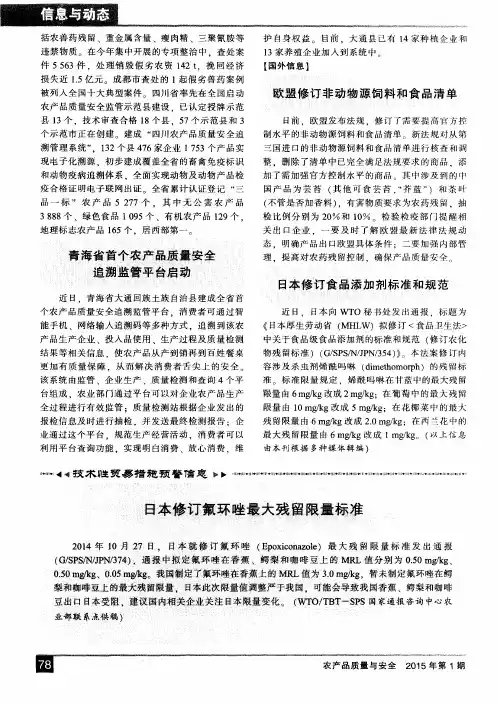
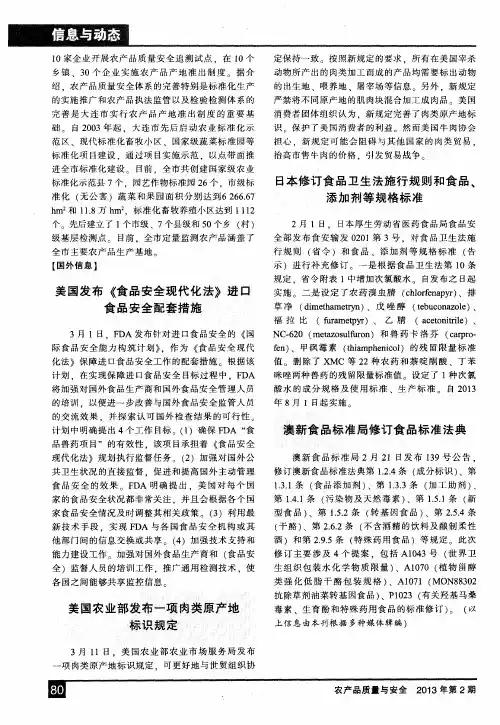
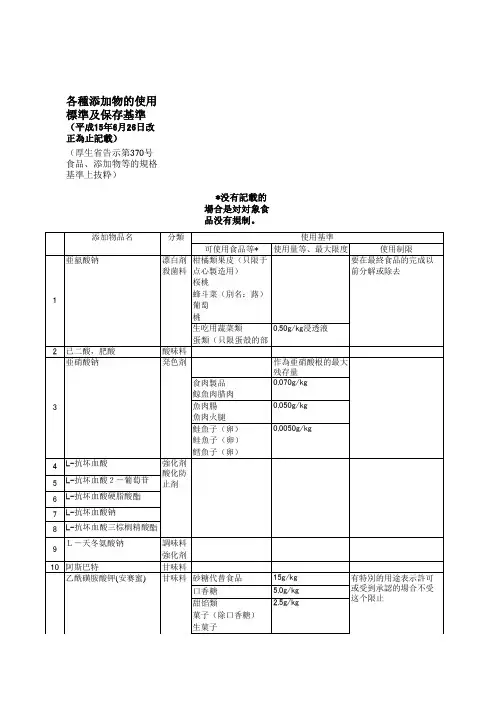
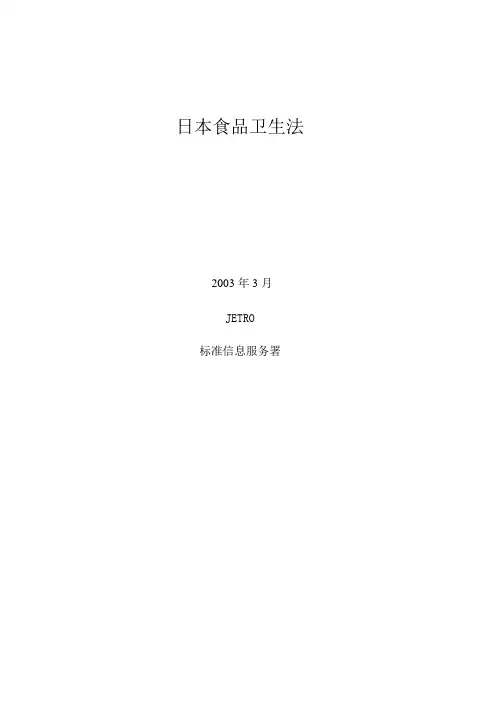
Major Use CategoryAdditivesTarget FoodsMaximum LimitsLimitation for UseppmAcidifiers Acetic Acid All foodsAcetic Acid, Glacial Adipic Acid Citric Acid Fumaric Acid Gluconic Acid Glucono-δ-Lactone Lactic Acid DL-Malic Acid Succinic Acid D-Tartaric Acid DL-Tartaric AcidAnti-cakingFerrocyanides of Calcium,Potassium and SodiumSaltIndividually or in combination,0.020g/kg asanhydrous sodium ferrocyanide Anti-foaming agent Silicone resin All foods0.050 g/kg Only for defoaming.Anti-molding agentsDiphenylGrapefruit 0.070 g/kg Lemon 0.070 g/kg Orange0.070 g/kg ImazalilBanana 0.0020 g/kg Citus fruits0.0050 g/kg(except mandarin orange)o-Phenylphenol Sodium o -Phenylphenol Citrus fruitsThiabendazoleBanana (whole)0.0030 g/kg Banana (pulp)0.0004 g/kg Citrus fruits0.010 g/kgAntioxidantsL-Ascorbic Acid All foods L-Ascorbyl Palmitate L-Ascorbyl StearateButylated Hydroxyanisole (BHA)as BHA Butter 0.2 g/kg Fats & oils0.2 g/kg Fish & shellfish (dried)0.2 g/kg Fish & shellfish (salted)0.2 g/kg Fish & shellfish (frozen)1 g/kg of dip(except frozen products cosumed raw)Mashed potato (dried)0.2 g/kg Whale meat (frozen)1 g/kg of dip(except frozen products cosumed raw) Standards for Use, according to Use Categorieseffective from June 04, 2009When BHA is used incombination with BHT, the total amount of both shall not exceed the corresponding limit.as maximum residue limitas maximum residue limit as maximum residue limit of o -phenylphenol 0.010g /kg as maximum residue limitAntioxidants Butylated Hydroxytoluene as BHA (continued) (BHT)Butter0.2 g/kg Chewing gum 0.75 g/kg Fats & oils0.2 g/kg Fish & shellfish (dried)0.2 g/kg Fish & shellfish (salted)0.2 g/kg Fish & shellfish (frozen) 1 g/kg of dip(except frozen products cosumed raw)Mashed potato (dried)0.2 g/kg Whale meat (frozen)1 g/kg of dipCalcium Disodium as EDTA-CaNa 2 Ethylenediamine-0.035 g/kg tetraacetate0.25 g/kgBread Fruit juiceas EDTA-CaNa 20.035 g/kg Other canned and bottled foods 0.25 g/kgErythrobic AcidAll foodsIsopropyl CitrateButter0.10 g/kg Fats and oils0.10 g/kg Guaiac ResinButter1.0 g/kg Fats and oils 1.0 g/kg Propyl GallateButter 0.10 g/kg Fats and oils0.20 g/kgSodium L-Ascorbate All foods Sodium ErythorbateAll foodsdl -α-Tocopherol All foodsAntisticking D-Mannitol Candies40 %Chewing gum20 %FURIKAKE (sprinkleover only products containing granues)RAKUGAN (dried rice-flour cakes)30 %25 %All foods as CHOMIRYO (seasoning)*When BHA is used incombination with BHT, the total amount of both shall not exceed the corresponding limit.(except frozen products cosumed raw)Canned and bottle non- alcoholic beveragesDisodium Ethylene- diaminetetraacetateCanned and bottle non- alcoholic beveragesOther canned and bottle foods Shall be chelated with calcium ino before the preparation of the finished food.Not permitted for nutritive purposes in fish pasteproducts (excluding SURIMI)or bread.Only for antioxidizing purposes in other foods.as monoisopropyl citrate Not permitted for nutritive purposes in fish pasteproducts (excluding SURIMI)or bread.Only for antioxidizing purposes in other foods.Only for antioxidizing, except when included in preparation of β-Carotene, Vitamin A,Vitamin A Esters of Fatty Acids, or Liquid Paraffin.L-Cysteine Monohydro- chlorideTSUKUDANI (food boiled down in soy sauce, only products made of KONBU (kelp))50 % of granules (as maximum residue limit)* When used in formula with Potassium Chloride andGlutamate for seasoning foods or enhancing their original flavor, no limits are specified. (only cases where D-Mannitol does not exceed 80% of the sum of Potassium Chloride, Glutamates and D-Mannitol)Color fixatives Ferrous Sulfate All foodsPotassium Nitrateless than:Meat products 0.070 g/kg Whale meat bacon0.070 g/kg (as residue limit of NO 2Sodium Nitrate as maximum Sodium Nitriteresidue limit of nitrite Fish ham 0.050 g/kg Fish sausage0.050 g/kg IKURA (salted/processed 0.0050 g/kg salmon roes)Meat products0.070 g/kg SUJIKO (salted salmon roes)0.0050 g/kg TARAKO0.0050 g/kg Whale meat bacon 0.070 g/kg Color adjuvant Ferrous GluconateTable olive0.15 g/kgDietary SupplementsL-Ascorbic acid 2-glucoside All foodsBiotin Foods with health claims Bisbentiamine All foodsCalcium Carbonate*as Ca Calcium Chloride All foods1.0 %Calcium Citrate Chewing gum*10 % *Calcium Dihydrogen Pyrophosphate Calcium Dihydrogen PhosphateCacium GluconateCalcium Glycerophosphate Calcium HydroxideCalcium LactateDietary Supplements Calcium Monohydrogen All foods(continued)PhosphateCalcium Pantothenate Calcium SulfateCholecalciferolAll foodsSame as for Potassium NitrateThe above limits do not apply to foods approved to be labeled as "special. dietary use."Only when indispensable for manufacturing or processing the food, or when used for nutritive purposes.* Only applied to Calcium CarbonateMay also be used as dietary supplement.See the section, "Dietary supplements"Only for nutritive purposes.Only when indispensable for manufacturing or processing the food, or when used for nutritive purposes.Only when indispensable for manufacturing or processing the food, or when used for nutritive purposes.Only when indispensable for manufacturing or processing the food, or when used for nutritive purposes.May be used as fermentation regulator. See the section,"Miscellenous."Dietary Supplements Copper Gluconateas copper(continued)Substitutes for human milk0.60 mg/LFoods with health claims5 mg/recommended daily portion of each foodCupric Sulfateas copper Substitutes for human milk0.60 mg/LDibenzoyl Thiamine All foodsDibenzoyl Thiamine Hydrochloride Dry Formed Vitamin A ErgocalciferolFerric Ammonium Citrate Ferric Chloride Ferric Citrate Ferric Pyrophosphate Ferrous GluconateDried milk for pregnant and lactating women.Substitutes for human milk.Weaning foodsFolic AcidAll foodsL-Histidine Monohydro- chloride Iron Lactate L-Isoleucine L-Lysine L-Aspartate L-Lysine L-GlutamateL-Lysin Monohydrochloride DL-Methionine L-Methionine Methyl Hesperidin Nicotinamide Nicotinic Acid L-Phenylalanine All foodsPyridoxine Hydrochloride RiboflavinRiboflavin 5'-Phosphate SodiumRiboflavin Tetrabutyrate Sodium Ferrous Citrate Sodium Pantothenate Thiamine Dicetylsulfate Thiamine Dilaurylsulfate Thiamine Hydrochloride Thiamine Mononitratewhen formulated into a standard concentration.The limit does not apply to cases where these additives are used in formulated dried milk under approval by the Minister of Health, Labor and Welfare.Not permitted in freshfish/shellfish (including fresh whale meat) or meat.May also be used as color adjuvant.See the section, "Color adjuvant."when formulated into a standard concentration.The limit does not apply to cases where these additives are used in formulated dried milk under approval by the Minister of Health, Labor and Welfare.ppmDietary Supplements Thiamine Naphthalene-All foods(continued) 1, 5-disulfonateThiamine ThiocyanateDL-ThreonineL-Threonineall-rac-α-Tocopheryl Acetate Foods with health claims as α-TocopherolR,R,R-α-Tocopheryl Acetate150mg/recommendeddaily portion of eachfoodTricalcium Phosphate All foods as Ca1.0 %DL-Tryptophan All foodsL-TryptophanL-ValineVitamin AVitamin A Esters ofFatty AcidsVitamin A in OilZinc Gluconate Only substitutes for human milk as zincFoods with health claims15 mg/ recommendeddaily portion of eachfoodZinc Sulfate Only substitutes for human milk as zincEmulsifiers Calcium Strearoyl LactylateBread. 4.0 g/kgButter cakes. 5.5 g/kgConfections(baked or fried wheatflour products only).4.0 g/kgMoist cakes (rice flour products only). 6.0 g/kgMacaroni and other such products.* 4.0 g/kg**as dry noodles.Mixed powder:for manufacturing bread. 5.5 g/kgfor manufacturing confections (friedwheat flour products only).5.5 g/kgfor manufacturing confections(baked wheat flour products only).5.0 g/kgfor manufacturing moist cakes (riceflour products only).10 g/kgfor manufacturing sponge cakes,butter cakes and steamed breads.8.0 g/kgfor manufacturing steamedMANJYU (bun made by steamingwheat flour dough).2.5Noodles(excluding instant noodles and dry noodles)4.5 g/kg**** as boiled noodles.6.0 mg/LWhen formulatedinto a standardconcentration.Not applied to cases where theOnly when indispensable formanufacturing or processingthe food, or when used fornutritive purposes.The above limit donot apply to foodsapproved to belabeled as "special.dietary use."6.0 mg/LWhen formulatedinto a standardconcentration.additives is used in for-mulated dried milk underapproval by the Minister ofHealth, Labor and Welfare.Not applied to cases where theadditives is used in for-mulated dried milk underapproval by the Minister ofHealth, Labor and Welfare.ppm Emulsifiers Calcium Strearoyl Lactylate Sponge cakes.5.5 g/kg (continued)(continued)Steamed bread (bread made by steaming wheat flour dough). 5.5 g/kg Steamed MANJYU2.0 g/kgGlycerol Esters of Fatty All foodsAcids LecithinPolysorbate 20as polysorbate 80Polysorbate 60 Capsule- and tablet-form foods excluding confections 25 g/kg Polysorbate 65 Chewing gum5.0 g/kg Polysorbate 80Cocoa and chocolate products 5.0 g/kg Milk-fat substitutes 5.0 g/kg Sauces5.0 g/kg Seasonings for instant noodles 5.0 g/kg Shortening5.0 g/kg Bakery confections3.0 g/kg Decorations for confections 3.0 g/kg (Sugar coatings and icings) Dressing 3.0 g/kg Ice creams 3.0 g/kg Mayonnaise3.0 g/kg Mix powder for bakery confections and moist sweet cake3.0 g/kg Moist sweet cake, unbaked cake 3.0 g/kg(Including fruit tart, cream cake, rare cheese cake, custard pudding, and like products)Sweetened yoghurt 3.0 g/kg Candies1.0 g/kg Edible ices including sherbet 1.0 g/kg Flour paste* 1.0 g/kg Soup1.0 g/kg Pickled sea weed 0.50 g/kg Pickled vegetables 0.50 g/kg Chocolate drinks 0.50 g/kg Unripened cheese0.080 g/kg Canned and bottled sea weed 0.030 g/kg Canned and bottled vegetables 0.030 g/kg Other foods 0.020 g/kgPropylene Glycol Esters All foodsof Fatty Acids Sorbitan Esters of Fatty AcidsSucrose Esters of Fatty AcidsFilm-forming agentsMorpholine Salts of Fatty Acids Rind of fruits Polyvinyl Acetate*Rind of vegetablesSodium OleateFlavoring agents AcetaldehydeAll foodsOnly for flavoring.AcetophenoneAliphatic Higher Alcohols (excluding substances generally recognized as highly toxic)Aliphatic Higher Aldehydes (excluding substances generally recognized as highly toxic)If it is used together with one of polysorbate 60, 65, and 80,the sum of each amount used shall be not more than the corresponding maximum levels as polysorbate 80. The above standards are not applied for products that are approved or recognized as foods for special dietary use.Flour paste*: In this list, flour paste is confined to paste products of cocoa andchocolate that are prepared with sugar, fat/oil, powder milk,egg, or wheat flour as secondary ingridients, and pasteurized.They are used asfillings or coatings of bread or bakery confections.* Polyvinyl Acetate may also be used as chewing gum base.See the section, "Chewing gum base."Only as film-forming agent.ppmFlavoring agents Alphatic Higher Hydro-All foods Only for flavoring. (continued) carbons (excluding sub-stances generally recog-nized as highly toxic)Ally CyclohexylpropionateAlly HexanoateAlly IsothiocyanateAmylalcoholα-AmylcinnamicaldehydeAnisaldehydeAromatic AlcoholsAromatic Aldehydes(excluding substancesgenerally recognized ashighly toxic)BenzaldehydeBenzyl Acetate.Benzyl AlcoholBenzyl Propionated-BorneolButanolButyl AcetateButyl ButyrateButyraldehydeButyric AcidCinnamic AcidCinnamaldehydeCinnamyl AcetateCinnamyl AlcoholCitralCitronellalCitronellolCitronellyl AcetateCitronellyl FormateCyclohexyl AcetateCyclohexyl ButyrateDecanalDecanol2,3-Dimethylpyrazine2,5-Dimethylpyrazine2,6-DimethylpyrazineEstersEthersppmFlavoring agents Ethyl AcetateAll foods(continued)EthanolYeast extract Vinyl acetate resinEthyl Acetoacetate All foods Only for flavoring.Ethyl Butyrate Ethyl Cinnamate Ethyl Decanoate Mixture of2-Ethyl-3,5-dimethylpyrazine and 2-Ethyl-3,6-dimethylpyrazine Ethyl Heptanoate Ethyl Hexanoate Ethyl Isovalerate 2-Ethyl-3-methylpyrazine Ethyl Octanoate Ethyl Phenylacetate Ethyl Propionate Ethylvanillin 1,8-Cineole Eugenol Fatty AcidsFurfural and its derivatives (excluding substances generally recognized as highly toxic)Geraniol Geranyl Acetate Geranyl Formate Hexanoic Acid Hydroxycitronellal Hydroxycitronellal Di- methylacetalIndole and its derivatives Ionone Isoamyl AcetateOnly for flavoring, execpt when:1. Used for denaturing ethanol which is used for the removal astringency of persimons, the manufacture of crystalline fructose, the preparation of granules or tablets of spices, or the manufacture of KONNYAKU-KO (Konjac powder), or which is used as a solvent for Butylated Hydroxytoluene of ButylatedHydroxyanisole or as an ingredient for the manufacture of vinegar;2. Used for accelerating- yeast-autolysis in the extract (water-soluble fraction obtained by autolysis of yeast;)3. Used as a solvent for vinyl acetate resin.Ethyl Aceteta used in manu-facturing yeast extract shall be removed before the preparation of the finished food.ppmFlavoring agents Isoamylalcohol All foods Only for flavoring. (continued)Isoamyl ButyrateIsoamyl FormateIsoamyl IsovalerateIsoamyl PhenylacetateIsoamyl PropionateIsobutanolIsobutyraldehydeIsobutyl PhenylacetateIsoeugenolIsopropanolIsothiocyanates(excluding substances generallyrecognized as highly toxic)IsovaleraldehydeKetonesLactones(excluding substancesgenerally recognized ashighly toxic)LinaloolLinalyl AcetateMaltoldl-Mentholl-Mentholl-Menthyl AcetateMethyl Athranilate2-MethylbutanolMethyl CinnamateMethyl N-Methylanthra-nilateMethyl β-Naphthyl Ketone5-MethylquinoxalineMethyl Salicylatep-Methylacetophenoneγ-NonalactoneOctanall-PerillaldehydePhenethyl AcetatePhenols(excluding substancesgenerally recognized ashighly toxic)Phenol Ethers(excluding substancesgenerally recognized as highly toxic)PiperonalPropanolPropionic Acid* Terpene Hydrocarbons TerpineolTerpinyl Acetate * Propionic Acid may also be used as preservative. See the section, "Preser-vatives."ppmFlavoring agents 2,3,5,6-Tetramethylpyrazine All foods Only for flavoring.(continued)Thioethers(excluding substances generally recognized as highly toxic)Thiols(excluding substances generally recognized as highly toxic)2,3,5-Trimethylpyrazine γ-Undecalactone Valeraldehyde VanillinFlour treatment agents Ammonium Persulfate Wheat flour 0.30 g/kgBenzoyl PeroxideWheat flourChloride Dioxide Wheat flourDiluted Benzoyl Peroxide Wheat flour0.30 g/kgPotassium BromateBread (only products made of wheat 0.030 g/kg of wheat flour)flourFood Colors Annato, water-solubleβ-CaroteneCopper Chlorophyllas copper 0.0004 g/kgChewing gum 0.050 g/kg Chocolate0.0010 g/kg Fish-paste products 0.030 g/kg (excluding SURIMI)Fruits and vegetables for preserva-0.10 g/kgtion.*KONBU (kelp)0.15 g/kg of dry kelp Copper Chlorophyll Moist cakes (excluding bread with 0.0064 g/kg(continued)sweet fillings or toppings)Can be used only as diluted Benzoyl Peroxide by mixing with one or more of Alum, calcium salts of Phosphoric Acid, Calcium Sulfate, CalciumCarbonate, Magnesium Carbonate, and Starch.Not permitted in fresh fish/shellfish including (fresh whale meat), KONBU (kelp)/WAKAME (sea weed) (both Laminariales ), legumes/pulses, meat NORI (laver), tea,or vegetables.Agar jelly in MITSUMAME (prepared by mixing agar jelly,cut fruits, gree beans, etc. with sugar syrup) packed into cans or plastic containers.* Foods which are processed for preserving, including dried foods, salted foods, pickled foods in vinegar, and preserved foods in syrup.Shall be decomposed or removed before thepreparation of the finished food.Not permitted in fresh fish/shellfish (including whale meat), KONBU(kelp)/WAKAME (sea weed)(both Laminariales ),legumes/pulses, meat, NORI (laver) (except when gold is used on NORI), tea leaves,or vegetables.ppmFood Colors Food Blue No. 1 (Brilliant (continued)Blue FCF) and its Alumi- num LakeFood Blue No. 2 (Indigo Carmine) and its Alumi- num LakeFood Green No. 3 (Fast Green FCF) and its Alu- minum LakeFood Red No. 2 (Amaranth) and its Aluminum Lake Food Red No. 3 (Erythro- sin) and its Aluminum Lake Food Red No. 40 (Allura Red) and its Aluminum LakeFood Red No. 102 (New Coccine)Food Red No. 104 (Phloxine)Food Red No. 105 (Rose Bengale)Food Red No. 106 (Acid Red)Food Yellow No. 4 (Tartra- zine) and its Aluminum LakeFood Yellow No. 5 (Sunset Yellow) and its Aluminum LakeFood colors other than chemically synthesized food additivesIron Sesquioxide Banana (stem only)KONNYAKU (konjac)Preparations of tar colors Same as for Food Blue No. 1.Sodium Copper Chlorophyllin as copper0.0004 g/kgCandies0.020 g/kg Chewing gum 0.050 g/kg Chocolate0.0064 g/kg Fish-paste products (except SURIMI)0.040 g/kg Fruits and vegetables for preserva-0.10 g/kgtion.*KONBU (kelp)0.15 g/kg of dry kelp Sodium Copper Chlorophyllin Moist cakes (excluding bread with 0.0064 g/kg (continued)sweet fillings or toppings)Syrup0.064 g/kgNot permitted in fish pickles,fresh fish/shellfish (including whale meat) KASUTERA (a type of pound cake), KINAKO (roasted soybean flour),KONBU (kelp)/WAKAME (sea weed) (both Laminariales ),legumes/pulses, marmalade,meat, meat pickles, MISO (fermented soybean paste),noodles (including Wantan),NORI(laver), soy sauce,sponge cakes, tea leaves,vegetables, or whale meat pickles.Not permitted in fresh fish/shellfish (including whale meat), KONBU(kelp)/WAKAME (sea weed)(both Laminariales ),legumes/pulses, meat, NORI (laver) (except when gold is used on NORI), tea leaves, or vegetables.Agar jelly in MITSUMAME (pre-pared by mixing agar jelly, cut fruits, gree beans, etc. with sugar syrup) packed into cans or plastic containers.* Foods which areprocessed for preserving,including dried foods, salted foods, pickled foods in vinegar, and preserved foods in syrup.ppmFood Colors Sodium Iron Chlorophyllin(continued)Titanium DioxideHumectant Sodium Chondroitin Sulfate Fish sausage 3.0 g/kgMayonnaise20 g/kgDressing20 g/kgInsecticide Piperonyl Butoxide Cereal grains0.024 g/kgNon-nutritive Sweeteners Acesulfame Potassium An (sweetened bean paste) 2.5 g/kgConfectionary 2.5 g/kgChewing gum 5.0 g/kgEdible ices (including sherbets, 1.0 g/kgflavored ices, and other similarfoods)Fermented milk*0.50 g/kgFlour paste 1.0 g/kg.Ice creams 1.0 g/kgJam 1.0 g/kgFoods with health claims 6.0 g/kg(only tablets)Lactic acid bacterial bevarages* 0.50 g/kgMilk drinks*0.50 g/kgMiscellaneous alcoholic beverages*0.50 g/kgMoist cakes 2.5 g/kgNonalcoholic beverages0.50 g/kgPickles 1.0 g/kgSugar substitutes**15 g/kgTare (a dip or sauce mainly for 1.0 g/kgJapanese or Chinese foods)Wine*0.50 g/kgOther foods 0.35 g/kgAspartameDisodium Glycyrrhizinate MISO (fermented soybean paste)Soy sauceSaccharin Chewing gum0.050 g/kgSodium Saccharin as residue limitof sodium saccharineless than:KOZI-ZUKE (preserved in KOJI, 2.0 g/kgfermented riceSU-ZUKE (vinegar-pickled foods)TAKUAN-ZUKE (rice bran-pickledradishes)Only for coloring.Not permitted in fish pickles, fresh fish/shellfish (including whale meat) KASUTERA (a type of pound cake), KINAKO (roasted soybean flour), KONBU (kelp)/WAKAME (sea weed) (both Laminariales), legumes/pulses, marmalade, meat, meat pickles, MISO (fermented soybean paste), noodles (including Wantan), NORI(laver), soy sauce, sponge cakes, tea leaves, vegetables, or whale meat pickles.** Products used bydirectly adding to drinks, such as coffee and tea.* Applied to dilutions, in the case of concentratedproducts.These maximum limits donot apply to foodsapproved to be labeledas special dietary use. Same as for Annato, water-solubleppm Non-nutritive sweeteners Sodium Saccharin Nonalcoholic beverages (powdered) 1.5 g/kg (continued)(continued)KASU-ZUKE (lee-pickled foods) 1.2 g/kgMISO-ZUKE (MISO-pickled foods)SHOYU-ZUKE (soy sauce-pickledfoods)Fish/shellfish (processed, excludingfish paste, TSUKUDANI (foodsboiled down with soy sauce),pickles, and canned or bottledfoods)Processed sea weeds0.50 g/kgSimmered beansSoy sauceTSUKUDANI (foods boiled down withsoy sauce)Edible ices0.30 g/kgFish pasteLactic acid bacterial drinksMilk drinksNonalcoholic beveragesSaucesSyrupVinegarAn (sweetened bean paste)0.20 g/kgFermented milkFlour pasteIce cream productsJamsMISO (fermented soybean paste)Pickles (preserved or pickled foods,excluding those listed in thiscolumn)Confectionary0.10 g/kgCanned or bottled foods, excluding 0.20 g/kgthose listed above.D-Sorbitol All foodsSucralose Chewing gum 2.6 g/kgConfectionary 1.8 g/kgJam 1.0 g/kgLactic acid becterial beverages*0.40 g/kgMilk drinks*0.40 g/kgMiscellaneous alcoholic bverages*0.40 g/kgMoist cakes 1.8 g/kgNonalcoholic beverages*0.40 g/kgSake*0.40 g/kgSake (compounded)*0.40 g/kg Sugar substitutes**12 g/kg Wine (any kind of fruit wine)*0.40 g/kg Other foods0.58 g/kg** Products used by directly adding to drinks, such as coffee and tea.* Applied to dilutions, in the case of concentratedproducts.These maximum limits do not apply to foods approved to be labeled as special dietary use. These maximum limits donot apply to foodsapproved to be labeledas special dietary use.(less than 1.5 g/kg in case of materials for nonalcoholic beverage or lactic acid bacteria drinks or fermented milk product to be diluted not less than 5-fold before use, less than 0.90 g/kg in case of vinegar to be deluted not less than 3-fold before use)ppmNon-nutritive sweeteners Xylitol All foods(continued)D-XylosePreservatives Benzoic Acid Caviar 2.5 g/kgMargarine 1.0 g/kgNonalcoholic beverages0.60 g/kgSoy sauce0.60 g/kgSyrup0.60 g/kgButyl p-Hydroxybenzoate as p-hydroxybenzoicacidFruit sauce0.20 g/kgnonalcoholic beverages0.10 g/kgRind of fruits and fruit vegetables 0.012 g/kgSoy sauce0.25 g/LSyrup0.10 g/kgVinegar0.10 g/LCalcium Propionate as propionic acidBread and cakes 2.5 g/kgCheese 3.0 g/kgEthyl p-HydroxybenzoateIsobutyl p-HydroxybenzoateIsopropyl p-HydroxybenzoateNisinAs polypeptidecontaining Nisin A Cheese (except processed cheese)0.0125g/kgMeat productsWhipped creamsDressing0.010g/kgMayonnaiseSauces*Fine bakery products0.00625g/kgProcessed cheeseMISO (fermented soybean paste)0.0050g/kgProcessed eggs productsMoist, unbaked, sweet cakes mademaainly of cereal grains or starch**0.0030g/kgPotassium Sorbate as sorbic acid0.30 g/kg When the additive is used in margarine with Sorbic Acid or Potassium Sorbate, or a preparation containing either of these two additives, the total amount of them as benzoic acid and as sorbic acid shall not be more than 1.0 g/kg.When the additive is used in cheese with Sorbic Acid or Potassium Sorbate, or a preparation containing either of these two additives, the total amount of them as propionic acid and as sorbic acid shall not be more than 3.0 g/kg.Same as for Butyl p-Hydroxybenzoate.AMAZAKE (beverages made from fermneted rice using KOJI (Asp. oryzae), and confined toproducts to be coonsumed in 3- fold or more dilution.)Cheese: When used in combination with propionic acid, calcium propionate, or sodium propionate, total level of the additives as sorbic acid and as propionic acid shall not be more than 3.0 g/kg.The maximum use levels are not apply to products permmited or recognized by the Minister of Health, Labour and Welfare as foods for special dietary uses. The foods include five types of products: foods for the ill, milk powder for pregnant and lactating women, formulated milk powder for infants, foods for the aged, foods for specified health uses.* Sauces refer to all kinds of sauces including Oriental thick Worcester sauce, cheese souce, and ketchup, but excluding fruit sauce and its analogues used for cakes.** They refer to rice pudding and tapioca puding, and their analogues, but excluding Oriental sweet dumplings.ppmPreservative Potassium Sorbate AN (sweetened bean paste) 1.0 g/kg(continued)(continued)Candied cherries 1.0 g/kgCheese 3.0 g/kgDried fish/shellfish (excluding 1.0 g/kgsmoking cuttlefish & octopus)Dried prune0.50 g/kgFermented milk (as raw materials for0.30 g/kglactic acid bacterial drinks)Fish-paste products (excluding 2.0 g/kgSURIMI)Flour paste products for bread and 1.0 g/kgconfectionaryFruit juice (including concentrated 1.0 g/kgfruit juice) for confectionaryFruit paste for confectionary 1.0 g/kgGnocchis 1.0 g/kgJams 1.0 g/kgKASU-ZUKE (lees-pickled foods) 1.0 g/kgKetchup0.50 g/kgKOJI-ZUKE (KOJI (Asp. oryzae)- 1.0 g/kgpickled foods)Lactic acid bacterial beverages (ex-0.050 g/kg cluding sterilized bevarages)Lactic acid bacterial beverages (as 0.30 g/kg ingredients of lactic acid bacterialbeverages, excluding sterilizedbeverages)Margarine 1.0 g/kg Meat products 2.0 g/kg Miscellaneous alcoholic beverages 0.20 g/kg MISO (fermented soy bean paste) 1.0 g/kg MISO-ZUKE (MISO-pickled foods) 1.0 g/kg Salted vegetables 1.0 g/kg Sea urchin products 2.0 g/kg SHOYU-ZUKE (soy sauce-pickled 1.0 g/kg foods)Simmered beans 1.0 g/kg Smoked cuttlefish & octopus 1.5 g/kg Soup (excluding potage-type soup)0.50 g/kg SU-ZUKE (vinegar-pickled foods)0.50 g/kg Syrup 1.0 g/kg TAKUAN-ZUKE (rice bran-pickled 1.0 g/kg radish)TARE (a dip or sauce mainly for 0.50 g/kg Japanese or Chinese foods)TSUKUDANI (foods boiled down in 1.0 g/kg soy sauce)TSUYU (a sauce mainly for Japanese0.50 g/kg noodles)Whale meat products 2.0 g/kg Wine (any kind of fruit wine)0.20 g/kg When the additive is used in margarine with Benzoic Acid or Sodium Benzoate, the total amount of them as benzoic acid and as sorbic acid shall not be more than 1.0 g/kg.When the additive is used in MISO-ZUKE, the total amount of Sorbic Acid used in the product, and Sorbic Acid and its salts cntaining in MISO as ingredient shall not be more than 1.0 g/kg.3.0 g/kg.。
美国、欧盟、日本食品添加剂的监管一、美国食品添加剂管理美国食品和药品管理法规第201款规定,食品添加剂是直接或间接进入食品并成为食品一部分的任何物质。
所谓直接食品添加剂,是指直接加入到食品中的物质。
所谓间接食品添加剂,是指包装材料或其他与食品接触的物质,在合理的预期下,转移到食品中的物质。
根据这个定义,食品配料也是食品添加剂的一部分,这是美国与大多数国家对食品添加剂定义的不同之处。
美国法律规定,由FDA(食品药物管理局)直接参与食品添加剂法规的制定和管理。
因肉类由美国农业部(USDA)管理,用于肉和家禽制品的添加剂需得到FDA和USDA双方的认证;而酒和烟由酒烟草税和贸易局(TTB)管理,用于酒、烟的食品添加剂也实行双重管理。
食品添加剂立法的基础工作往往由相应的协会承担。
如食品香精立法的基础工作由FEMA(美国食品香料和萃取物制造者协会)担任,其安全评价结果得到FDA认可后,以肯定的形式公布,并冠以GRAS (一般公认安全)的FEMA号码。
随着科技进步和毒理学资料的积累,以及现代分析技术的提高,每隔若干年后,食品添加剂的安全性会被重新评价和公布。
美国食品和药品管理法第402款规定,只有经过评价和公布的食品添加剂才能生产和应用,否则会被认定为不安全。
含有不安全食品添加剂的食品则“不宜食用”,不宜食用的食品禁止销售。
美国规定,食品中公认为可安全使用的物质不属于食品添加剂范畴,但对这类物质的使用也实行严格管理。
FDA已推行一项新的公认安全物质的通报系统,即由生产企业向FDA提交其产品,根据其用途属于公认安全物质的报告,FDA在一定时间内(通常为180天),向申请人发信确认或否认申请的物质的公认安全性。
二、欧盟食品添加剂管理由于欧盟是一个统一的市场,因此食品添加剂产品一旦进入某一欧盟成员国市场,原则上即可在其他成员国自由销售。
和其他国家相同,欧盟也有专项法规对食品添加剂进行管理。
欧盟食品添加剂的使用原则是食品中只能含有欧盟允许使用的食品添加剂和成员国允许使用的香料,即使用食品添加剂必须符合欧盟的相关规定和一般卫生法规的要求。
前ページへ *記載のない場合は対象食品の規制はない。
使用できる食品等*使用量等の最大限度チオエーテル類(ただし、毒性が激しいと一般に認められるものを除く。
)チオール類(別名チオアルコール類)(ただし、毒性が激しいと一般に認められるものを除く。
)調味料強化剤デカナールデカノールデカン酸エチル鉄クロロフィリンナトリウム着色料 5,6,7,8-テトラヒドロキノキサリン2,3,5,6-テトラメチルピラジンチーズデヒドロ酢酸としてバター0.50g/kgマーガリンテルピネオールテルペン系炭化水素類デンプングリコール酸ナトリウム糊料2.00%銅としてこんぶ(無水物)0.15g/kg 野菜類又は果実類の貯蔵品0.10g/kg シロップ0.064g/kg チューインガム0.050g/kg 着色料(化学的合成品を除く)着色料香料香料L-テアニン 使用基準香料品名(日文)分類香料デヒドロ酢酸ナトリウム保存料銅クロロフィリンナトリウム着色料魚肉ねり製品(魚肉すり身を除く)0.040g/kgあめ類0.020g/kg チョコレート生菓子(菓子パンを除く)みつ豆缶詰又はみつ豆合成樹脂製容器包装詰中の寒天0.00040g/kg銅としてこんぶ(無水物)0.15g/kg 野菜類又は果実類の貯蔵品0.10g/kg チューインガム0.050g/kg 魚肉ねり製品(魚肉すり身を除く)0.030g/kg 生菓子(菓子パンを除く)0.0064g/kg チョコレート0.0010g/kg みつ豆缶詰又はみつ豆合成樹脂製容器包装詰中の寒天0.00040g/kg トコフェロール酢酸エステル強化剤保健機能食品150mg未満/当該食品1日摂取目安量(a-トコフェロールとして)d -a-トコフェロール酢酸エステル強化剤保健機能食品150mg未満/当該食品1日摂取目安量(a-トコフェロールとして)DL-トリプトファン調味料L-トリプトファン強化剤2,3,5-トリメチルピラジン香料DL-トレオニン調味料L-トレオニン強化剤ナイシンAを含むポリペプチドとして食肉製品チーズ(プロセスチーズを除く)0.0064g/kg銅クロロフィル着色料dl -a-トコフェロール(ビタミンE)酸化防止剤ナイシン保存料0.0125g/kgホイップクリーム類(乳脂肪分を主成分とする食品を主要原料として泡立てたもの)ソース類ドレッシングマヨネーズプロセスチーズ洋菓子卵加工品味噌洋生菓子(穀類及びでん粉を主原料としたもの)0.0030g/kgナタマイシン製造用剤ナチュラルチーズ(ハード及びセミハードの表面部分に限る)0.020g/kg未満ニコチン酸強化剤ニコチン酸アミド製造用剤漂白剤保存料酸化防止剤かんぴょう 5.0g/kg未満乾燥果実(干しぶどうを除く) 2.0g/kg未満干しぶどう 1.5g/kg未満コンニャク粉0.90g/kg未満乾燥じゃがいもゼラチンディジョンマスタード0.010g/kg0.00625g/kg0.0050g/kg ナトリウムメトキシド製造用剤二酸化硫黄二酸化硫黄としての残存量0.50g/kg未満果実酒(果実酒の製造に用いる酒精分1容量パーセント以上を含有する果実搾汁およびこれを濃縮したものを除く)雑酒キャンデッドチェリー糖蜜糖化用タピオカでんぷん0.25g/kg未満水あめ0.20g/kg未満天然果汁(5倍以上に希釈して飲用に供するもの)0.15g/kg未満甘納豆煮豆えび冷凍生かにその他の食品(キャンデッドチェリーの製造に用いるさくらんぼ、ビール製造に用いるホップ並びに果実酒に用いる果汁、酒精分1容量パーセント以上を含有する果実搾汁およびこれを濃縮したものを除く)二酸化塩素小麦粉処理剤小麦粉0.30g/kg未満0.10g/kg未満0.10g/kg未満(そのむき身につき)0.030g/kg未満0.35g/kg未満2.00%(ケイ酸カルシウムと併用する場合は、それぞれの使用量の和)二酸化炭素製造用剤 乳酸酸味料 乳酸カルシウム強化剤カルシウムとして1.0%(特別用途表示の食品を除く)乳酸鉄強化剤 乳酸ナトリウム調味料 γ-ノナラクトン香料 ノルビキシンカリウムノルビキシンナトリウムバニリン香料 パラオキシ安息香酸イソプチル パラオキシ安息香酸としてパラオキシ安息香酸イソプロピルしょう油0.25g/L パラオキシ安息香酸エチル果実ソース0.20g/kg パラオキシ安息香酸ブチル酢0.10g/L 清涼飲料水シロップ果実及び果菜の表皮0.012g/kgパラメチルアセトフェノン香料 調味料強化剤バレルアルデヒド香料 パントテン酸カルシウム強化剤カルシウムとして1.0%(特別用途表示の食品を除く)パントテン酸ナトリウム強化剤 ビオチン強化剤保健機能食品L-ヒスチジン塩酸塩ビスベンチアミン二酸化ケイ素製造用剤 微粒二酸化ケイ素製造用剤二酸化チタン着色料着色料 保存料強化剤パラオキシ安息香酸プロピル0.10g/kg L-バリン ビタミンAビタミンA脂肪酸エステルビタミンA油(油性ビタミンA脂肪酸エステル)ヒドロキシシトロネラールヒドロキシシトロネラールジメチルアセタールヒドロキシプロピルセルロース製造用剤ヒドロキシプロピルメチルセルロース製造用剤ピペリジン香料ピペロナール香料ピペロニルブトキシド防虫剤穀類0.024g/kg氷酢酸酸味料 ピラジン香料ピリドキシン塩酸塩強化剤 ピロ亜硫酸カリウム漂白剤二酸化硫黄としての残存量保存料かんぴょう 5.0g/kg未満酸化防止剤乾燥果実(干しぶどうを除く)2.0g/kg未満干しぶどう 1.5g/kg未満コンニャク粉0.90g/kg未満乾燥じゃがいもゼラチンディジョンマスタード果実酒(果実酒の製造に用いる酒精分1容量パーセント以上を含有する果実搾汁およびこれを濃縮したものを除く)雑酒キャンデッドチェリー糖蜜糖化用タピオカでんぷん0.25g/kg未満強化剤 香料 ピロ亜硫酸ナトリウム0.50g/kg未満0.35g/kg未満0.30g/kg未満水あめ0.20g/kg未満天然果汁(5倍以上に希釈して飲用に供するもの)0.15g/kg未満甘納豆煮豆えび冷凍生かにその他の食品(キャンデッドチェリーの製造に用いるさくらんぼ、ビール製造に用いるホップ並びに果実酒に用いる果汁、酒精分1容量パーセント以上を含有する果実搾汁およびこれを濃縮したものを除く)ピロリジン香料ピロリン酸四カリウム製造用剤 製造用剤強化剤ピロリン酸二水素二ナトリウム製造用剤 ピロリン酸第二鉄強化剤ピロリン酸四ナトリウム製造用剤 調味料強化剤フェニル酢酸イソアミルフェニル酢酸イソブチルフェニル酢酸エチル2-(3-フェニルプロピル)ピリジンフェネチルアミン0.10g/kg未満0.10g/kg未満(そのむき身につき)0.030g/kg未満ピロリン酸二水素カルシウムカルシウムとして1.0%(特別用途表示の食品を除く)L-フェニルアラニン 香料 フェノールエーテル類(ただし、毒性が激しいと一般に認められるものを除く。
Standards for Use, according to Use CategoriesBleaching agents (continued)Sulfur Dioxide (continued)Wine (any kind of fruit wine, excluding squeezed fruit juice containing alcohol of not less than 1% by volume which is used for manufacturing wine and a concentrate of the same.)0.35 g/kgOther foods (excluding cherry used for candied cherry, hop used for brewing beer, fruit juice used for manufacturing wine, and squeezed fruit juice containing alcohol of not less than 1 % by volume, and and a concentrate of the same.)0.030 g/kgChewing gum bases Ester Gum Chewing gumOnly as chewing gum base.Polybutene Polyisobutylene Polyvinyl Acetate*Color fixatives Ferrous Sulfate All foodsPotassium Nitrateless than:Meat products 0.070 g/kg Whale meat bacon0.070 g/kg (as residue limit of NO 2Sodium Nitrate as maximum Sodium Nitriteresidue limit of nitrite Fish ham 0.050 g/kg Fish sausage0.050 g/kg IKURA (salted/processed 0.0050 g/kg salmon roes)Meat products0.070 g/kg SUJIKO (salted salmon roes)0.0050 g/kg TARAKO 0.0050 g/kg Whale meat bacon0.070 g/kg Color adjuvantFerrous GluconateTable olive0.15 g/kg (as residue limit of iron)Dietary Supplements L-Ascorbic acid 2-glucoside All foodsFormulated dried milk Substitutes for human milk 10m g/100kcal Foods with health claimsBisbentiamine All foodsCalcium Carbonate*as CaCalcium Chloride All foods 1.0 %Calcium Citrate Chewing gum*10 % *Calcium DihydrogenPyrophosphateCalcium Dihydrogen Phosphate Cacium Gluconate**Calcium Glycerophosphate**Calcium HydroxideCalcium LactateMay also be used as dietary supplement.See the section, "Dietary supplements"* Polyvinyl Acetate may also be used as film-forming.See the section, "Film-forming agents."**Only for nutritive purposes.BiotinSame as for Potassium NitrateThe above limits do not apply to foods approved to be labeled as"special. dietaryuse."Only when indispensable for manufacturing or processing the food, or when used for nutritive purposes.* Only applied to Calcium CarbonateOnly when indispensable for manufacturing or processing the food, or when used for nutritive purposes.May be used as fermentation regulator. See the section, "Miscellenous."Preservative Calcium SorbateTSUYU (a sauce mainly for Japanese 0.50 g/kg(continued)(continued)noodles)Whale meat products 2.0 g/kg Wine (any kind of fruit wine)0.20 g/kgEthyl p -Hydroxybenzoate Isobutyl p -Hydroxybenzoate Isopropyl p -Hydroxybenzoate NisinAs polypeptide containing Nisin A Cheese (except processed cheese)0.0125g/kgMeat products Whipped creams Dressing 0.010g/kgMayonnaise Sauces*Fine bakery products 0.00625g/kgProcessed cheeseMISO (fermented soybean paste)0.0050g/kgProcessed eggs productsMoist, unbaked, sweet cakes made maainly of cereal grains or starch**0.0030g/kgPotassium Sorbate Propionic AcidPropyl p -Hydroxybenzoate Sodium Benzoateas benzoic acidCaviar2.5 g/kg Fruit paste and fruit juice (including concentrated juice) used for manufacturing confectionary. 1.0 g/kgMargarine1.0 g/kg Nonalcoholic beverages 0.60 g/kg Soy sauce 0.60 g/kg Syrup0.60 g/kg Sodium DehydroacetateButter 0.50 g/kg Cheese 0.50 g/kg Margarine0.50 g/kgSodium PropionateSame as for Butyl p -Hydroxybenzoate.Same as for Calcium PropionateSame as for Butyl p-Hydroxybenzoateas dehydroaceticSame as for Calcium PropionateThis additive may also be used as flavoring agent. See the section, "Flavoring agents."The maximum use levels are not apply to productspermmited or recognized by the Minister of Health,Labour and Welfare as foods for special dietary uses. The foods include five types of products: foods for the ill, milk powder for pregnant and lactating women, formulated milk powder for infants,foods for the aged, foods for specified health uses.* Sauces refer to all kinds of sauces including Oriental thick Worcester sauce, cheese souce, and ketchup, but excluding fruit sauce and its analogues used for cakes.** They refer to rice pudding and tapioca puding, and their analogues, but excluding Oriental sweet dumplings.Same as for Calcium Sorbate When the additive is used in margarine with Sorbic Acid, Calcium Sorbate or Potassium Sorbate, or a preparationcontaining these additives, the total amount of them as benzoic acid and as sorbic acid shall not be more than 1.0 g/kg.。